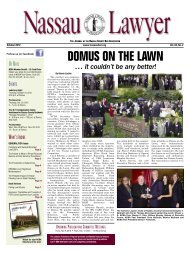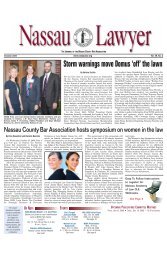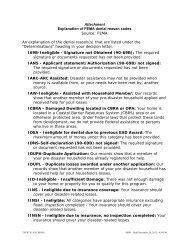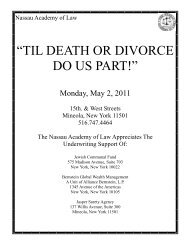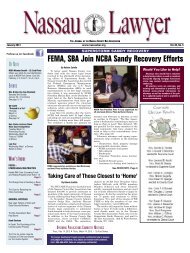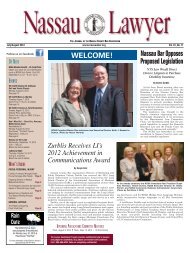FRAUDULENT CONVEYANCES Nassau Academy of Law CLE Live ...
FRAUDULENT CONVEYANCES Nassau Academy of Law CLE Live ...
FRAUDULENT CONVEYANCES Nassau Academy of Law CLE Live ...
Create successful ePaper yourself
Turn your PDF publications into a flip-book with our unique Google optimized e-Paper software.
example, from net 15 to COD; or change in the type <strong>of</strong> payment, for example fromregular business check to certified check.The most common pro<strong>of</strong> <strong>of</strong> ordinary course is in counting the days betweeninvoice and payment, and comparing the length <strong>of</strong> time for payment during theperiod prior to the 90 days preference period to the length <strong>of</strong> time for paymentduring the preference period.Case law is uniform in using the actual payment period to define theordinary course, rather than the invoice terms. Thus, if the terms are net 30, butthe payments were usually between 45 - 60 days, then ordinary course will bedefined by the 45 - 60 period, not 30. From there, however, methods <strong>of</strong> countingdiffer wholly from judge to judge. It is not an exaggeration to say that there is apublished decision to support or oppose any position on counting ordinary coursewhich a party wishes to propound.For example, if payment during the pre-preference period was between 45 -60 days after invoice, with an average <strong>of</strong> 50 days, and a mean <strong>of</strong> 49, should thecourt analyze the preference period payments by comparing the range <strong>of</strong> days, theaverage or the mean? If the court chooses the average, how many days <strong>of</strong>f <strong>of</strong> theaverage must a payment be before it out <strong>of</strong> the ordinary - 3, 7, 14?It is at this point that the third part <strong>of</strong> the test comes into play. ViewingSubsection 547(c)(2)(B) as a subjective test, and Subsection 547(c)(2)(C) as anobjective test, the Sixth Circuit Court <strong>of</strong> Appeals has held that the creditor mustpresent evidence under the subjective test that the payment in question wasordinary in relation to prior conduct between that debtor and that creditor, andunder the objective test showing that the payment is ordinary in relation to thestandards prevailing in the relevant industry.3. SettlementsBecause <strong>of</strong> the uncertainties surrounding the various defenses to apreference action, preference suits are usually settled, not litigated through to trial.If the court does not give some indication <strong>of</strong> its view on the issues raised by thedefendant, either through a published decision or comments at a pre-trialconference, it is <strong>of</strong>ten helpful to make a motion for summary judgment. Often thefacts are not in dispute. Rather it is the application <strong>of</strong> the law that is uncertain.That is why summary judgment is <strong>of</strong>ten used. Even if facts are in dispute so thatthe motion can not be granted in full, the court will usually take the opportunity toprovide guidance in the parties in future settlement discussions, and may grantpartial summary judgment to help clarify and simplify the issues.



